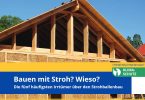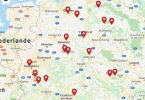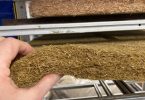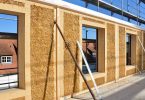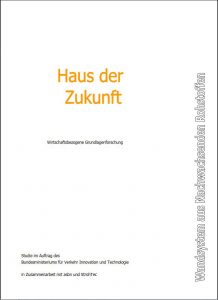 Beside a good marketing concept, a successful implementation of new products into the market of building products is dependent on technical approval. It is the aim of this work to guide the innovative straw bale building method from the experimental stage to the professional stage and to support its market introduction by providing the necessary product certificates, tools for an efficient and effective quality management and optimised constructions, suitable for passive houses. Therefore, research and development work has been done on three different levels:
Beside a good marketing concept, a successful implementation of new products into the market of building products is dependent on technical approval. It is the aim of this work to guide the innovative straw bale building method from the experimental stage to the professional stage and to support its market introduction by providing the necessary product certificates, tools for an efficient and effective quality management and optimised constructions, suitable for passive houses. Therefore, research and development work has been done on three different levels:
- building technical tests to provide certificates for fire resistance and heat insulation, to meet the criteria of the Austrian and European Building Codes.
- Optimising straw bale wall systems and connections of building components
- Developing a mobile straw bale testing lab to provide a tool to ensure an efficient and an
- effective quality management from the field to the straw bale house.
The used post and beam straw bale construction was tested at the Municipal Department 39 – Testing and Research Institute of the City of Vienna and led to some exceptionally good results concerning heat insulation and fire resistance. Thermal insulation of straw bales was already tested in the USA.
From these results a specific heat conductance of about (λ ; SI-unit: W/mK) 0,05 W/mK was expected. This would allow for a λ of 0,06 W/mK including the 20% humidity supplement for organic materials provided in Austria. The actual test results showed an even lower specific heat conductance of λ =0,0337 W/mK and 0,0380 W/mK. 20% humidity supplement strawbales yielded the following properties:
λ-value of 0,0404 W/mK and 0,0456 W/mK
The first value was measured according to ISO 8301:1991 (Thermal insulation – Determination of steady-state thermal resistance and related properties – Heat flow meter apparatus), the second one according to ÖNORM B 6015 Teil 1 (Determination of the thermal conductivity by the guarded hot plate apparatus). (Certificates see Appendix). These test results confirm the high performance of heat insulation of straw bales.
The fire resistance of the building material – the strawbales and that of the building component -the straw bale wallsystem, was tested. Building materials are classified into 4 different groups:
A not combustible
B1 hardly combustible
B2 normally combustible
B3 easily combustible
To be able to use building materials without legal restrictions, a certificate of the combustibility grading period of B2 is needed. Building components are classified into F30, F60, F90, which implies how many minutes the building component resists fire. Already made tests in the USA came to the result, that lack of oxygen in the compressed straw bales is responsible for high fire resistance. These experiences were confirmed with the tests made within the scope of the project. The straw bale and the straw bale wall system were tested according to ÖNORM B3800 (Certificates see Appendix).
The straw bale was classified as B2 and the tested straw bale wallsystem was classified as F90. These excellent test results show that high fire resistant constructions can be realized without chemical treatment of the straw bales. The avoidance of sources of error and the optimization of building junction elements is essential to guarantee high functionality of the products and to ensure passive house standards in the long term. Therefore 8 different wall systems, based on the post and beam straw bale wall (wooden framework construction with straw bales in-fill) were further developed and optimised.
All these constructions fulfil the passive house standards. The calculation of thermal storage capacity to avoid overheating shows low to middle values. The diffusion open constructions avoid humidity problems within the wall and even enable fast drying after unexpected water damages. Sound insulation is sufficient using double shell construction. Single shell constructions still have to be optimised. The chosen construction examples can be made airtight without any problem. Fire resistance is F90 without further adaptation. The connections of the straw bale wall to the other building components can be realised without creating thermal bridges. Water and electric installation causes no damage of the airtight layer. Connections of the straw bale wall to windows, ceiling and cellar can fulfil passive house standards.
To ensure top quality of straw as building material an efficient and effective quality management has to be built up. In this respect the development of a mobile testing lab for straw bales is the first major step. The testing equipment is responsible for the analysis and assessment of the quality of the straw bales. It also allows for the measurement of all relevant parameters of the bales. Bale dimensions, weight, temperature and humidity are measured. Furthermore, colour, shape, homogeneity, pureness of the bale and appearance of mould are analysed and assessed by the testing person. The measurement equipment fits in a specially developed suitcase.
Test series of the lab led to adaptation and optimization of the measuring equipment and proved its functionality. The lab provides a testing tool, which is easily applicable and reliable during the whole production process from the field to the straw bale house. An important point of the quality management is to avoid noxious animals and insects during storage of the bales and the construction of the building. The literature points out, that there are no such problems such as mice and insects, if the straw bale constructions are properly made. Furthermore, it is stated that clean straw has a low allergic potential.
Nevertheless it is important to use high quality bales and proper constructions, because badly constructed buildings and the use of humid straw bales or permanent penetration of water into the wall can cause mould growth and can reduce duration of use and occupant comfort considerably.
The results of the study lead to the conclusion, that straw bale building has a very high development potential, already pointed out in studies made in the USA. With this project, technical fundamentals are provided for the straw bale building sector and
necessary certificates support market introduction of this organic building material. So that this innovative building material is made available to the passive house sector. The study “Supporting and Hindering Factors for Renewable Resources in the Building Sector” points out that straw bale building can be used in many more fields than family houses. This conclusion leads to further R&D questions, which need to be worked out to enable the full economic potential of the straw bale building.
R&D work contains the following points:
- Improving dissemination of straw bale building
- Expanding the variety of straw bale constructions regarding technique and design
- Improving the availability of straw bales in the desired quantity and quality
- Enabling the full regional potential of straw bale building
- Maximising regional added value by local entrepreneurs and farmers
- Efficient co-operation structures for straw bale building
- Long term tests
With the current project “S-House” within the scope of call for “Haus der Zukunft” a straw bale demonstration project, based upon the results of this project will be put into practice. The “S-House” will help to disseminate all relevant information about building materials made out of renewable raw materials and ecologically sound constructions.


